Original Examples of the Chevrolet Camaro Z/28 Continue to Command Strong Prices From Collectors
1969 Chevrolet Camaro Z/28
06/16/2023

Photography courtesy of The Hemmings Archives
Buyer's Guides1969 Chevrolet Camaro Z/28

Its model name is just one letter and a two-digit number, but volumes have been spoken and written about it. It was listed in factory literature as the generic, ho-hum-sounding “Special Performance Package,” available on Camaro Sport Coupes, but the alphanumeric option code resonates more with enthusiasts: RPO Z28.
Ticking that box got you a homologation special powered by an exclusive 302-cu.in. engine with a mechanical cam, 11:1 compression, and a Holley four-barrel, conservatively rated at 290 horsepower. The little V-8 was a high-winding love child of key small-block specifications: a 4-inch bore (à la the 327 and later the 350) crossed with a 3-inch stroke (like the legendary 283’s throw). This combination allowed the engine to squeak in under the 305-cu.in. limit for SCCA Trans Am racing.
In keeping with the package’s road racing intentions, there was stiffer front and rear suspension, quicker steering, front disc brakes, a mandatory four-speed transmission, a standard 3.73:1 gear ratio packed in a 12-bolt axle, dual exhaust, and more. The Z/28 made its debut in 1967 and a scant 602 were built. For ’68, Z/28 production rose to 7,199 and nearly tripled for ’69 to more than 20,000.
As the most plentiful of the breed, the ’69 edition is a good candidate for anyone in the market for a first-generation Z/28. Popular price guides estimate that the average price of a ’69 Z/28 is $72,000, with a range of about $55,000 to $114,000. Desirable options can drive the price of a car up significantly, however. The JL8 four-wheel disc brakes or a Cross Ram intake, for instance, can be worth between $13,000- $30,000 each. Piling on the Rally Sport appearance package can add an estimated $8,000-$17,000 to the price of a ’69 Z/28. The ZL2 special ducted hood (i.e. cowl induction), can be worth $2,700-$5,700.
At Mecum’s Kissimmee sale in January a well-documented (two factory broadcast sheets, Protect-O-Plate, window sticker, and pre-delivery checklist) and nicely optioned Tuxedo Black 1969 RS Z/28— sporting a ducted hood and a Cross Ram intake—changed hands for $297,000. That was well above the pre-sale estimate of $185,000-$235,000. At the same sale, a Rally Green ’69 Z/28 with a partial build sheet, original warranty paperwork, and Protect-O-Plate failed to sell with a top bid of $90,000. Perhaps the one factor that kept it just out of six-figure territory was the seller’s note that a replacement 302 had been installed in the car back in 1976.
It almost goes without saying that a major factor in the value of one of these cars is a paper trail: a build sheet, original dealer invoices, the factory Protect-O-Plate, etc. A known history is a big help too, or authentication by an expert like Jerry MacNeish. If you’re serious about buying one of these, tracking down a copy of MacNeish’s book, The Definitive 1969 Camaro Z/28-SS396 Fact Book, is a good idea. These cars have been cloned for decades now, and unscrupulous or unwitting sellers are out there. With some care, you can find a nice ’69 Z/28 that will hold its value.

Photo courtesy of The Hemmings Archives
The ’69 Camaro has a style all its own with some marked exterior differences from the previous years’ offerings. The wheel openings in the ’69’s fenders and quarter panels were squared off, the grille was given a more aggressive V shape, a pair of round lamps was added to the valance, distinctive gill-shaped accent lines were stamped in ahead of the rear wheel, the taillamps were reshaped and divided in thirds, and more.
Very few parts of the ’69’s body are shared with previous years: the floorpan, the cowl vent, the hood, the roof skin, the rocker panels, the rear seatback divider, and the trunk lid among them. Rocker panels on coupes were galvanized for rust resistance and the bodies were hand sprayed with corrosion-resistant primers. Lower areas of the body were also coated with a rust inhibitor. That said, rust is the first-generation Camaro’s biggest enemy. The rear window channel and windshield channel are common trouble spots, as is the forward edge of the dashboard. The cowl assembly, the cabin floors, the trunk floor—particularly around the shock towers—and the shock towers themselves are all rust-prone areas, too. The lower front fenders, the door corners, and the quarter panels and inner wheelhouses are other common rust spots. Of course, the ’69 Camaro is an aftermarket darling and reproduction body panels have been available for these cars for decades. Complete aftermarket bodies are also available, or you can purchase the inner body structure without the skins.
With prices for these cars as high as they’ve been for years, it’s been worth rebuilding even the most badly deteriorated Z/28 for some time. A ’69 Z/28 that’s been completely overhauled correctly with replacement sheetmetal can be a drop-dead gorgeous concours winner. The value of the car, particularly if it’s been completely rebodied, might not be as high as a rare example claiming to have all of its original sheetmetal intact, however.
There’s nothing different about a Z/28 body to tell it apart from a standard Camaro. However, trim tags on some cars built in Norwood, Ohio, might have an “X code”—X77 denoted a base Z/28 Camaro and X33 denoted a Z/28 with style trim group. The Van Nuys/Los Angeles, California plant didn’t have X codes on their trim tags so Z/28s built there aren’t identifiable that way.
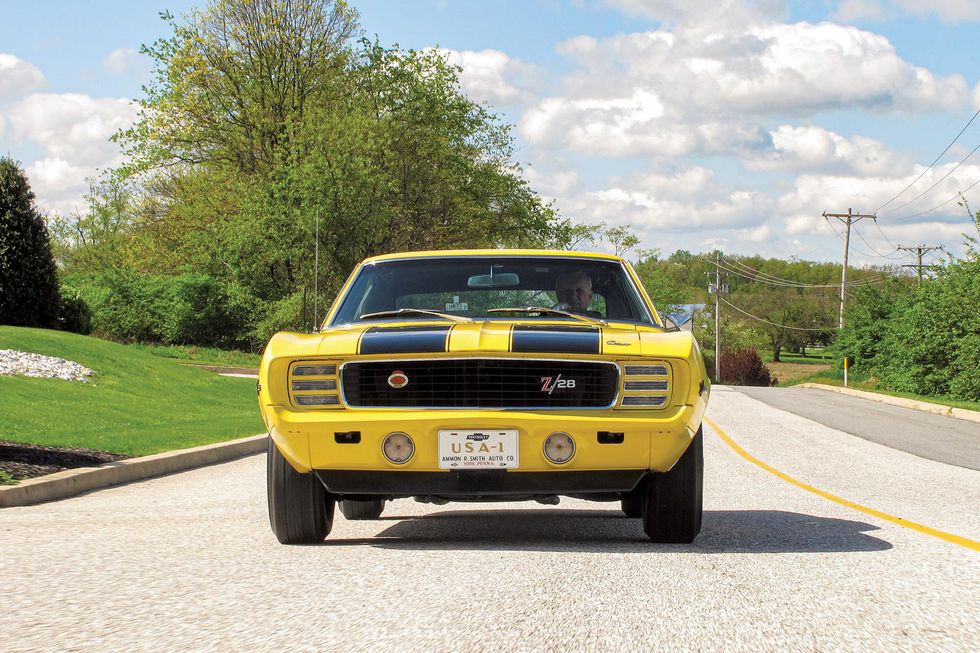
Photo courtesy of The Hemmings Archives
The Camaro is a unit-body car with a bolted-on front frame stub carrying the engine crossmember and the control arm/ coil-spring front suspension. In the rear, partial frame rail channels were welded into the floor pan to stiffen the body and serve as the rearmost attachment point for the leaf springs. Welded-in torque boxes serve as the front anchor point for the rear leaf springs. The Z/28 package included F41 heavy-duty suspension with stiffer front and rear springs as an upgrade from the base Camaro. A 11/16-inch anti-sway bar helped keep the Z level when cornering and a quick-ratio steering box boosted turn-in response.
Power-assisted brakes were mandatory on the Z/28. Up front, discs with single-piston calipers and 11-inch rotors were standard issue. In the rear, 9.5-inch drums were the base offering. The rare JL8 option upped the ante with 11.75-inch front and rear rotors and four-piston calipers.
The Camaro’s underpinnings are vulnerable to rust and, if serious enough, it can compromise the car’s structural integrity. The torque boxes that serve as the subframe and suspension mounting points can rust through, as can the rear frame channels. The front subframe can also rust around the body mount, particularly on the passenger side, and damage to the front crossmember from floor jacks is common.
Replacement parts are available as are complete and partial floors with the integral bits already attached. The heavier-gauge parts—the crossmember and frame rails—can be repaired by a skilled welder/ fabricator. Of course, if this sort of surgery has been performed, it’s crucial that everything has been reinstalled straight and securely. If in doubt, locate an expert through a local Camaro club or the Vintage Chevrolet Club of America and arrange for someone familiar with these cars to inspect the work that’s been performed.
The Camaro’s front suspension was a rugged and simple design—upper and lower control arms, ball joints, etc. Worn steering and suspension parts aren’t difficult to replace or rebuild and information about factory-correct assembly methods and finishes is widely available.
Photo courtesy of The Hemmings Archives
For ’69 the 302 had four-bolt mains and a large-journal crankshaft. The Chevrolet “30-30” camshaft was a 302 mainstay. Heads were iron with 2.02/1.60 valves and compression was a lofty 11:1.
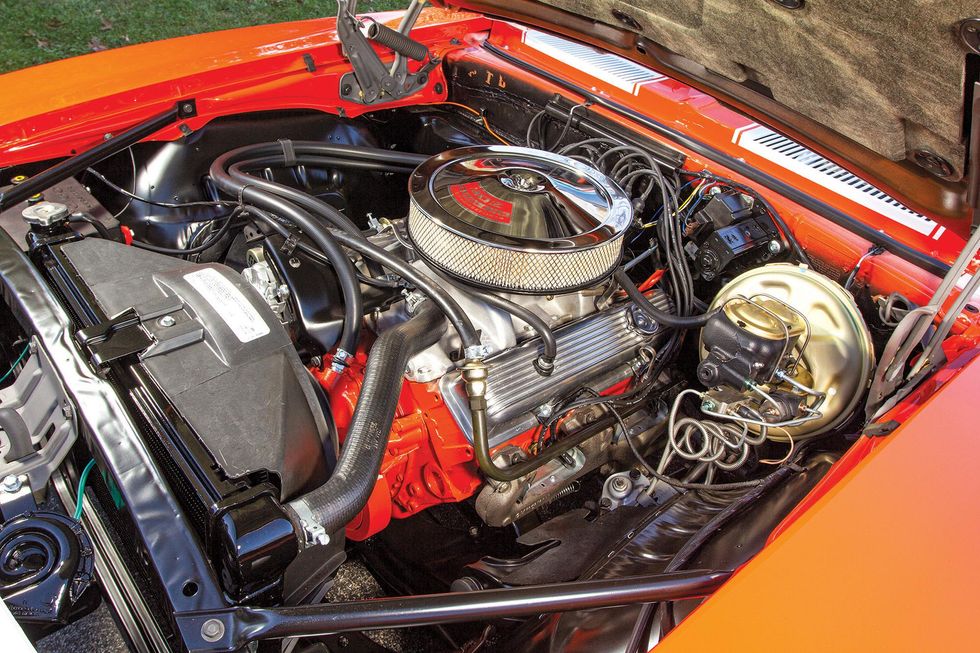

The ’69 302 was based on a block with four-bolt main caps and used a “large-journal” (2.1-inch rod and 2.449-inch main) forged-steel crankshaft. The connecting rods were shot-peened “pink” rods topped with impact-extruded aluminum (forged) pistons on full-floating wrist pins. The 302’s camshaft was the familiar (to Chevrolet small-block enthusiasts) “30- 30” solid-lifter cam with .485-inch lift and 254 degrees of duration (measured at .050 inches of lifter movement). Cast iron heads with 2.02-inch intake and 1.6-inch exhaust valves, a high-rise aluminum intake, and a 780-cfm Holley carburetor topped off the package. Obviously, an original numbers-matching engine is a major factor in the value of a car, as are correct accessories. The parts that make up the 302 in a Z/28 are not unique to that engine though so it’s possible to create one. Other than date codes that align with the car, what’s important is the stamping on the block pad in front of the right cylinder head (or near the oil filter or both) with the VIN number of the car and the suffix “DZ.” The stamp can be replicated, or it might have been machined away at some point if the engine was rebuilt. Experts can usually tell if a block has been machined and restamped in order to deceive buyers, so if in doubt, it’s worth the effort to consult with someone familiar with factory markings. If a Z/28 suffered an engine failure, back when it was still a late-model car, it might’ve had a service replacement engine installed at the dealer. Those were stamped CE on the block pad followed by a serial number. If there’s documentation to support that swap, it’s not the worst thing, but the car’s value will likely be affected.
A four-speed manual was the only transmission offered in the ’69 Z/28 but it could’ve been one of three: the “wide-ratio” Muncie M20 or the two “close-ratio” boxes—the M21 or the heavy duty M22. If the transmission is original to the car, it should have a partial VIN stamped on the side or top of the case. Gear noise is a characteristic of the M22 but those transmissions are uncommon in ’69 Z/28s. The other gearboxes should spin relatively quietly and shift smoothly. Popping out of gear when lifting off the throttle could be a sign of a shifter in need of adjustment or sloppy bushings. It could also mean that it’s time for a transmission rebuild. Muncie four-speeds are stout transmissions with a huge fanbase and widespread parts availability.
An 8.875-inch 12-bolt rear axle was mandatory under the ’69 Z/28. The standard gear ratio was 3.73:1 but factory literature notes the availability of 3.07:1, 3.31:1, 3.55:1, and 4.10:1. It also notes that Positraction was an option, but required with 4.10s, and that the 3.07 gearset was available only with the M20 (likely because of its deeper first, second, third, and reverse gears). The 12-bolt is a ruggedly built axle that’s easy to maintain and service. Excessive gear whine is a cause for concern as is chatter from a Positraction differential.
Photo courtesy of The Hemmings Archives
Nothing in the ’69 Z/28’s cockpit was specific to the model, like special badging or racing seats with embroidered headrests. The top-of-the-line interior got you door panels with pull straps and molded armrests, plus woodgrain accents. This example has houndstooth upholstery too.
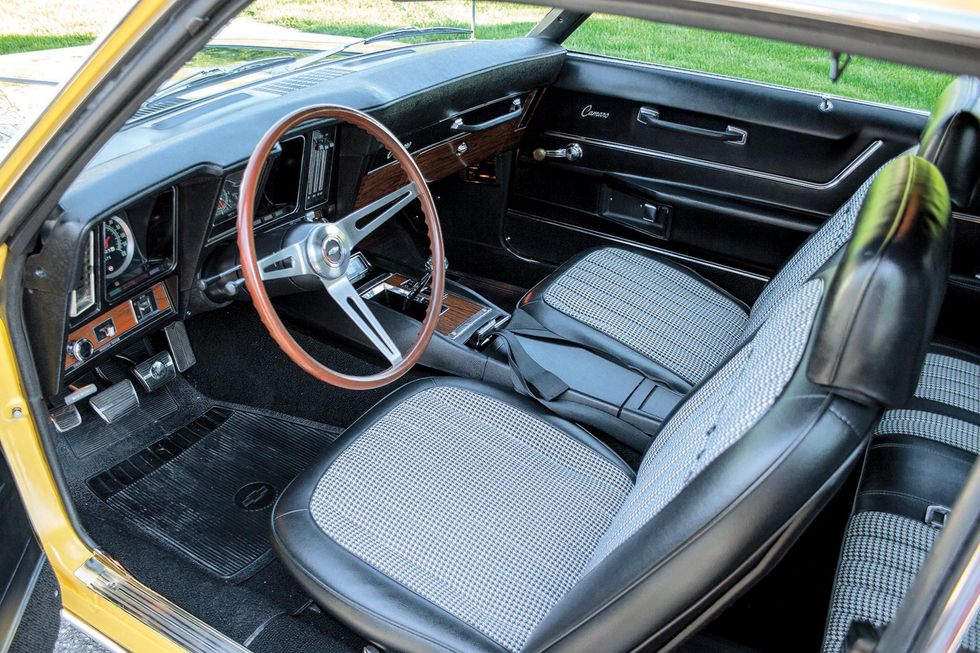

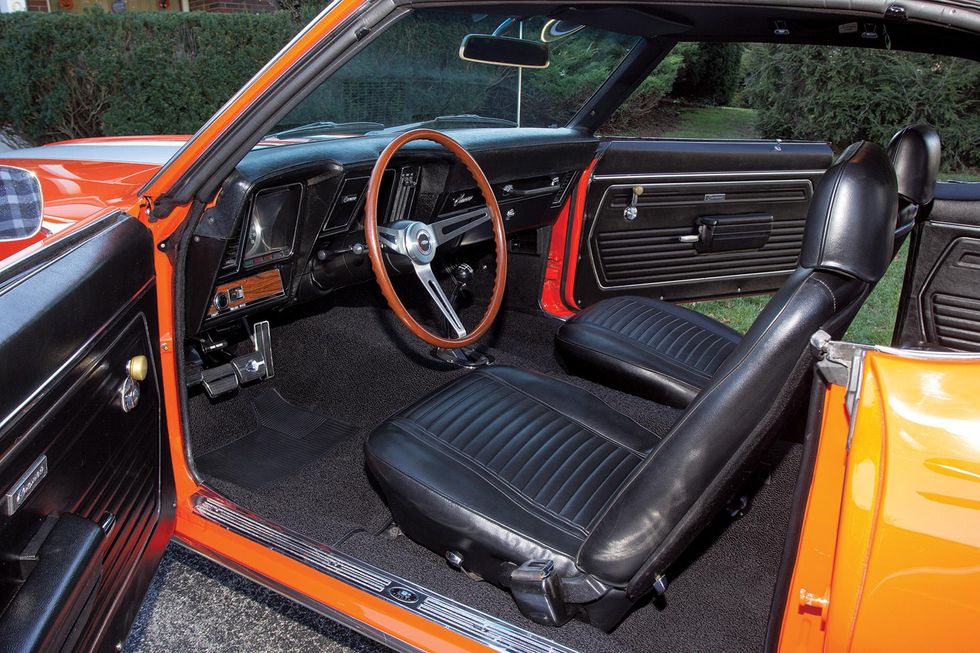
Circa-’69 there were no custom embroidered Z/28 headrests or special racing bucket seats to be had—the furniture in a Z/28 was identical to any other Camaro. The standard interior was all-vinyl upholstery on bucket seats. From there, buyers could upgrade to the deluxe interior with Comfortweave-insert vinyl upholstery or cloth houndstooth inserts, complimented by door panels with molded-in armrests and pull straps, as well as woodgrain dash/ steering wheel accents. All Z/28s had a Hurst shifter between the seats, either with or without an optional center console. Air conditioning was off the table in the Z/28—it wasn’t available with the 302. The Z/28 package didn’t include a full set of gauges either: a tachometer was an option as were auxiliary instruments mounted to the optional console. The aftermarket has first-generation Camaro interiors covered and everything needed to make a ’69 Z/28’s interior livable again is available.

Photo courtesy of The Hemmings Archives
Alternator (55 amp): $120
Exhaust system: $420
Front fender (without RS): $332
Quarter panel (full): $290
Interior kit (standard): $1,528
Interior kit (deluxe): $2,194
Power steering conversion kit: $1,074
Rear axle, 12-bolt, 3.73:1: $3,300
1969: Low-$55,000; Average-$72,000; High-$114,000
The Ford Mustang started the “Pony Car” revolution back in 1964. It is currently the longest-production nameplate in the Ford portfolio and remains the only car in their lineup. Originally, company officials, including legendary automotive executive Lido Anthony "Lee" Iacocca, predicted around 100,000 models to be sold per year. Instead, over 400,000 units were sold in its first year. Ford was literally “off to the races” with this one!
Originally sharing chassis commonality with the Ford Falcon, it grew into a shared structure with the Ford Pinto, the Fox platform, and since 2005, its own unique stampings. It is characterized by a long hood with a short rear deck design and lots of power under the hood, naturally.
Here is an overview of some of the coolest Ford Mustangs currently offered on Hemmings Marketplace.

Located in Kentucky, this 1965 Ford Mustang Convertible shows beautifully and is attracting quite a bit of attention on Hemmings. It features a 289 cubic-inch V8, a four-speed manual transmission, and Rangoon Red exterior. Refinished in 1999, the owner claims it “runs great and drives extremely well.” Recent work includes new front and rear bumpers, brakes, trunk liner, convertible top, seat covers and u-joints. The engine is believed to be original but the owner states partial VINs were only stamped on the blocks of high-performance engines, so that cannot be confirmed. The Code-5 manual transmission “shifts smoothly” and the “brand-new, power top works great,” according to its owner. Get it before it’s gone: This Mustang has already received a handful of offers.

This immaculate 1965 Ford Mustang Fastback features a sleek exterior and a rebuilt 289 cubic-inch four-barrel V8 engine updated for unleaded fuel. It’s matched to a rebuilt four-speed manual transmission with an upgraded clutch and a new GT exhaust. A rotisserie restoration occurred at 65,000 miles. It now shows 74K original miles on the odometer. All-new upholstery, door panels, dash pad, carpet and sound deadener bring the interior back to “almost new.” This Mustang sports new chrome all around with new Ford front and rear bumpers, gas cap, taillight lenses and more. It rides on Scott Drake Legendary Rims and lives in West Vancouver, British Columbia, Canada. The seller can help arrange delivery at an additional cost.

Originally built as a C-code Mustang with 302 cubic-inch V8 and air conditioning, this street-legal tribute car has been reimagined as a Shelby Racing Mustang Trans Am coupe. It features many new parts including quarter panels, trunk, floors, shock towers, door skins, fenders and more. Kirkey Vintage racing seats with Simpson five-point harnesses keep you firmly in place, while a quick disconnect racing steering wheel points the way. It’s powered by a NASCAR Craftsman Truck Series 358 cubic-inch V8 featuring Robert Yates Heads, titanium valves and a custom-built Holley 930 cfm road race carburetor by VDL Fuel Systems. No effort was spared in building this car that is as at home on the track as it is on the street.

This 1970 Ford Mustang Mach 1 is a resto-mod that underwent a rotisserie restoration some years ago. It’s powered by a 351 cubic-Inch Cleveland V8 producing 459-horsepower sent through a Tremec TKO five-speed manual transmission. A Detroit Locker equipped Strange Engineering 9-inch differential with 3.70:1 gearing puts the power to the pavement. The car includes a four-point roll cage, a period-correct AM/FM Cassette stereo, air conditioning, power steering, windows and brakes. The PPG-painted body includes a custom hood scoop and a modified stainless dual exhaust.
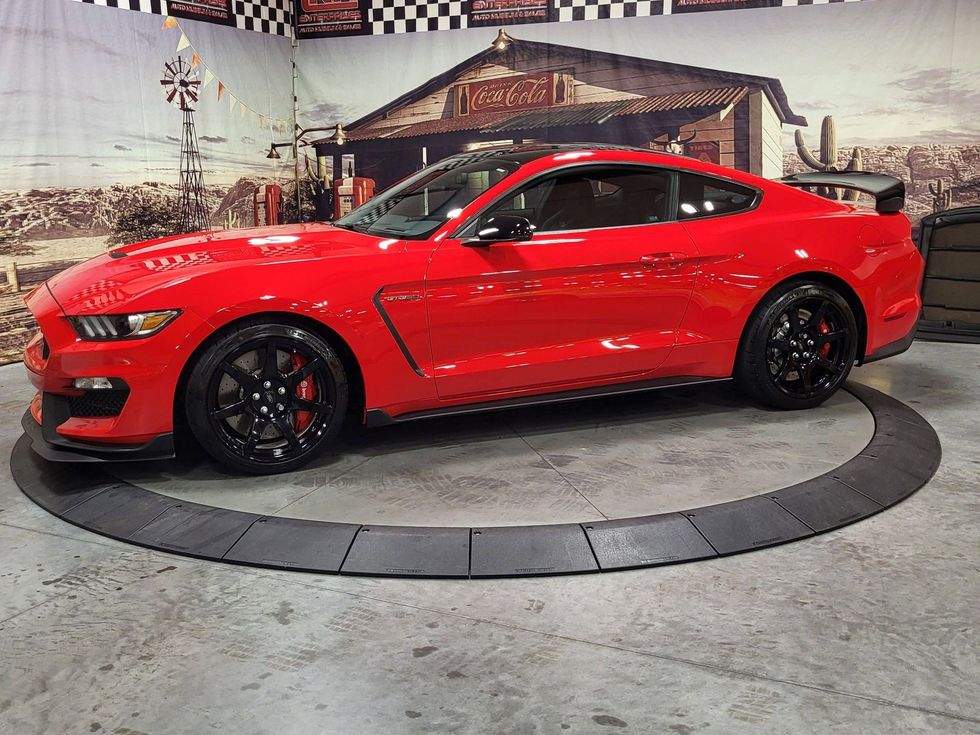
A Ford Shelby Mustang GT350 R, this limited-edition beauty is one of 49 GT350 Rs available in Race Red for the 2017 model year. With the R designating a “Race spec” model, it complies with various racing competition rules. Power is from a 526-horsepower Voodoo Coyote engine making 429 lb-ft of torque. It’s coupled to a Tremec six-speed manual transmission. Also on board are Brembo high-performance brakes, a MagneRide adjustable damper system and 19-inch carbon fiber wheels. The interior is complete with a pair of Recaro sport seats, the Shelby Track & Electronics Package, and a Voice-activated touchscreen display with navigation and Sync3.
General Motors was the object of plenty of criticism in the Eighties, much of it deserved as its divisions’ distinctions faded into differentiation by grille and trim alone, the identities of once-proud nameplates blurring into a corporate morass of cost-cutting and badge engineering. There were, however, still designers, engineers and more folks at GM who were legit car guys, doing everything they could to preserve the spirit of a company that not so many years before sold more than half the cars in the U.S.
In the 1980s, GM introduced an all-new Corvette that was light years ahead of its predecessor. It developed the turbocharged Buick Grand National, a quarter-mile-killing hot shot of a coupe at a time when the muscle car was supposedly dead. There were track-focused versions of the Camaro and Firebird. The company also managed to produce the Pontiac Fiero, a mid-engined, composite-bodied, rear-drive sports car that was probably the most exotic production car from GM to that point. This 1988 Pontiac Fiero GT, now offered at Hemmings Auctions, appears to be a highly original example of the final-year model that proved to be the best GM could make it.

At its introduction in 1983 for the 1984 model year, the Fiero was truly revolutionary, both in in its production as well as the car itself. Just look at some of the specifications of the first American-made, mid-engined two-seater: a plastic body over a space frame; ab engine mounted behind the driver and in front of the rear axle; fully independent suspension; four-wheel disc brakes, full instrumentation, rack-and-pinion steering and even an upshift light on four-speed manual cars.
Pontiac used the term “Enduraflex” to advertise the plastic body panels for the Fiero, but there were actually four different types of reinforced composite plastic used in the assembly of the car: sheet-molded compound for the hood, rear engine cover, upper quarter panels and roof; reaction injection-molded urethane for the front and rear bumper covers; reinforced reaction injection-molded urethane for the front fenders, doors and lower rear quarter panels; and thermoplastic olefin for the rocker panels. Even the pop-up headlamp covers were made of a composite plastic.

Marketing the car more as a sporty, economical commuter rather than an all-out sports car, Pontiac sold an astounding 136,840 Fieros for the 1984 model year, an impressive figure given a modest goal of 30,000 units. But all was not perfect in the Fiero-land.
Since we are talking 1980s GM here, compromises abounded to keep the cost of the otherwise exotic Fiero down to economy car standards. The only available engine in 1984 was the “Iron Duke,” a 2.5-liter OHV inline-four developed in the 1970s for economy. Even with electronic fuel injection and a 9.0:1 compression ratio, it could only muster 92 horsepower. The four-speed shifter had a reputation for being sloppy. The front suspension had been cribbed from the Chevette and the rear was a modified version of the strut front end of an X-car (Citation, et al.). A spate of engine fires required a recall in 1987 of nearly all 1984 Fieros.

Fortunately for enthusiasts, Pontiac engineers did not sit still and improvements began with the 1985 model, when a 140-horsepower 2.8-liter V6 was added to the options list, as was a five-speed manual—but only for the four-cylinder models. A slick fastback model joined the notchback version for 1986. Late in the ’86 model year, the Muncie/Getrag five-speed manual became the standard gearbox for the V6 cars. The body got a mild refresh for 1987, and, finally, in 1988, the entire suspension was redone, with revised control arms and steering knuckles up front and a new tri-link rear suspension with struts for the rear. Fatter stabilizers bars were used on both ends.
The road test magazines of the day that had cautiously endorsed the original Fiero while pointing to faults in previous years took no pause in praising the vastly improved car. Unfortunately, despite Pontiac finally getting the car right, much of the wind had gone out of the Fiero’s sales. For the 1988 model year, just 26,402 examples were sold, less than 20% of the 1984 model year. There would be no Fiero in Pontiac’s lineup after 1988.
This 1988 Pontiac Fiero GT now listed on Hemmings Auctions appears to be a clean, unmolested example of that final-year goodness. It features the vastly upgraded suspension, the fuel-injected V6 engine and a five-speed manual transmission. It’s also noted as being all original, save for an aftermarket cassette stereo system likely installed when the car was much closer to new.
With just under 73,000 miles on the odometer at the time of submission, this Fiero seems properly broken in but with plenty of miles still remaining to be enjoyed by its next driver. The Bright Red paint still seems to shine in the Florida sun where the seller is offering the car and the black lace alloy wheels show no discernible curb rash in the photos provided.
Take a look at what peak Fiero looks like on Hemmings Auctions and let us know what you think.